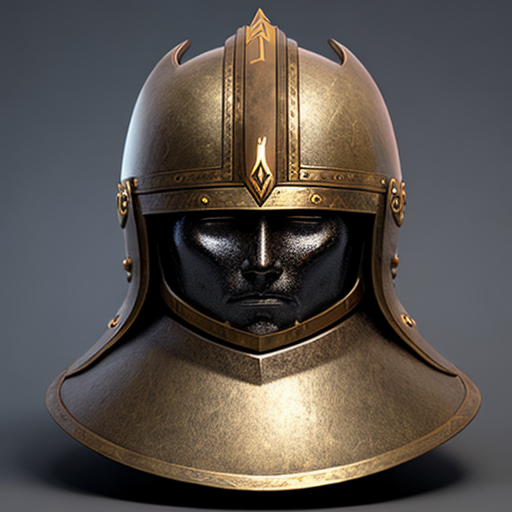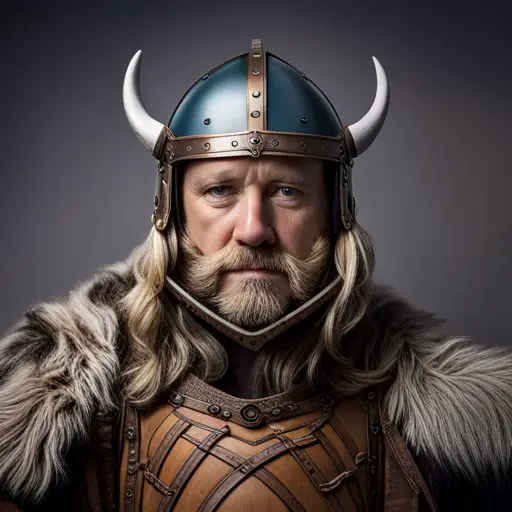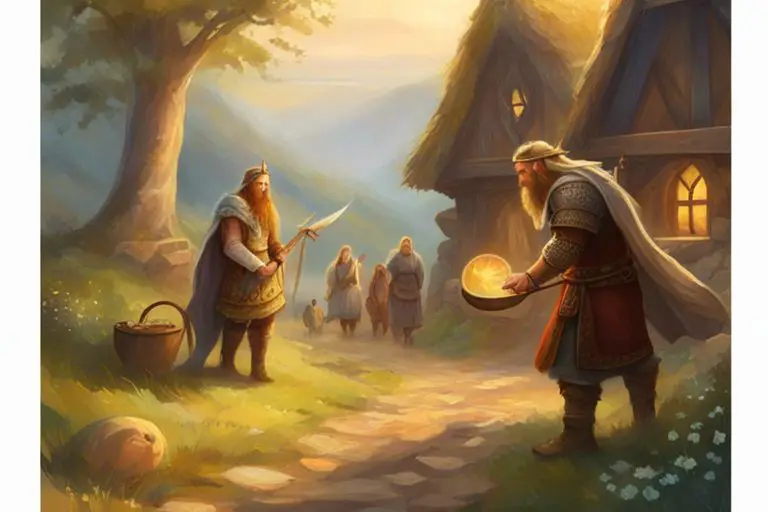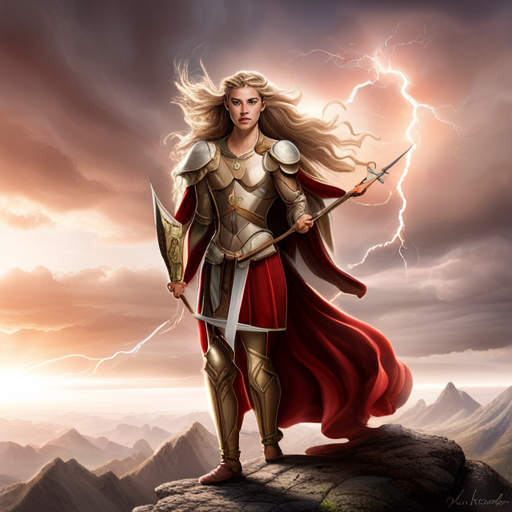As a fan of Norse mythology and Viking culture, I have always been fascinated by the iconic headgear worn by these fierce warriors. The image of a Viking helmet with its distinctive horns and intricate designs has become a symbol of strength, courage, and adventure.
But did you know that there were different types of Viking helmets, each with its own unique style and purpose?
In this article, I will explore the various types of Viking helmets worn by Norse warriors and their significance. From the classic Conical Helmet to the ornate Spangenhelm, each helmet tells a story of the Viking culture and their way of life.
So, join me on this journey as we delve into the world of Viking helmets and discover the iconic headgear of the Norse warriors.
The Conical Helmet
The conical helmet was a popular choice for protection among Viking warriors. It is the most iconic of all Viking helmets, with its classic look of a pointed helmet that covers the entire head.
These helmets were made from iron or bronze and were often decorated with intricate designs and symbols. The conical helmet’s design allowed for great protection of the head and neck, while also providing good visibility and ventilation. However, it was not without its flaws.
The pointed top made it difficult for warriors to wear in close combat, as it would often get stuck on low-hanging branches or other obstacles. This led to the development of the spangenhelm, which addressed this issue and became the more popular choice for Viking warriors.
The Spangenhelm
You may have seen this helmet on the heads of Norse warriors in movies and TV shows, but did you know that the spangenhelm was a popular choice for many other cultures throughout history?
The spangenhelm was a type of helmet that was made up of several metal plates that were riveted together. These plates were typically made from iron or bronze and were shaped to fit the head of the wearer.
The spangenhelm became popular in Europe during the 6th century and was used by many different cultures, including the Vikings, the Anglo-Saxons, and the Franks.
The helmet was designed to provide maximum protection for the head and face, and was often decorated with intricate designs and patterns. However, as time went on, the spangenhelm fell out of favor and was eventually replaced by other types of helmets, such as the spectacle helmet.
The Spectacle Helmet
You’re going to be fascinated by the history of the Spectacle Helmet and how it was a game-changer for medieval soldiers.
This helmet, also known as the Bifurcated Helmet, is characterized by its unique shape: two eye slits on the front and a nose guard that splits the helmet in two. This design allowed for better visibility and ventilation, making it more comfortable for the wearer.
The Spectacle Helmet was popular among Viking and Anglo-Saxon soldiers, and it was even worn by William the Conqueror during the Battle of Hastings in 1066.
To better understand the significance of the Spectacle Helmet, here are five key features that made it stand out among other Viking helmets:
– Improved visibility: The two eye slits on the front of the helmet allowed for better visibility in battle.
– Better ventilation: The split in the helmet allowed for better airflow, making it more comfortable to wear for long periods of time.
– Lightweight: The Spectacle Helmet was lighter than other helmets, making it easier to wear in battle.
– Affordable: The helmet was relatively cheap to produce, making it accessible to many soldiers.
– Versatile: The Spectacle Helmet was not only used by Viking warriors, but also by other medieval armies, including the Normans and Anglo-Saxons.
The Gjermundbu Helmet
Let’s delve into the history of the Gjermundbu helmet, a remarkable piece of medieval armor that has captivated historians and enthusiasts alike. This helmet is one of the most well-preserved examples of Viking headgear, and it was discovered in Norway in 1943, along with a range of other artifacts from the Viking Age.
The Gjermundbu helmet is made from iron and features a rounded cap with a small nose guard and a simple neck guard. The helmet also has two eye slots, which are covered with iron lattices that protect the wearer’s eyes without obstructing their vision. Interestingly, the helmet also has a chainmail aventail that covers the wearer’s neck and shoulders, providing additional protection.
The Gjermundbu helmet is believed to date back to the 10th century, and it is named after the farm where it was found. It is a testament to the Vikings’ advanced metalworking skills and their dedication to crafting high-quality armor that could withstand the rigors of battle.
As we move on to the next section about the Vendel helmet, it’s worth noting that the Gjermundbu helmet was not the only type of Viking helmet used during the Viking Age. Each helmet had its own unique design and purpose, and they were often customized to fit the wearer’s individual needs. The Vendel helmet, for example, is another iconic piece of Viking headgear that is known for its intricate decoration and elegant design.

The Vendel Helmet
Imagine yourself as a warrior of the early medieval period, donning the Vendel helmet, with its intricate silver decorations, and feeling the weight of its iron structure on your head.
This helmet was most likely worn by wealthy Viking warriors, adorned with silver and gold, and designed for both protection and style. The Vendel helmet was named after the Vendel era in Sweden, where it was discovered in the late 1800s.
This helmet was the precursor to the iconic spangenhelm, and it served as a transitional piece from earlier helmet designs to the more sophisticated ones of the Viking Age.
The Vendel helmet has a distinctive nose guard that extends down to the chin, providing additional protection to the face. Its iron frame was covered with silver decorations, including a silver dragon that runs along the nose guard, adding a touch of elegance to the helmet.
The Vendel helmet was also adorned with silver plaques that depict various scenes, including a warrior on horseback, holding a spear. These decorations not only made the helmet more aesthetically pleasing but also served as a symbol of the wearer’s wealth and status.
As a Viking warrior, wearing the Vendel helmet would have been a source of pride and a representation of your position within the community.
Frequently Asked Questions
What materials were used to make Viking helmets?
Did you know that despite the popular image of viking helmets being made of metal, only a small percentage of viking helmets discovered were made of this material?
In fact, most viking helmets were made of leather, padded with wool or fur for added protection. Metal helmets were reserved for the wealthiest of warriors, as they were more expensive to make.
This interesting statistic sheds light on the practicality and resourcefulness of the vikings, who utilized the materials they had available to create effective helmets for battle.
Did Viking warriors wear helmets in everyday life or just in battle?
As a history enthusiast, I’ve always wondered if Viking warriors wore helmets in their everyday lives or just in battle. After researching extensively, I discovered that helmets were not just reserved for battle, but were also worn in everyday life.
The Vikings valued their helmets as symbols of status, and sometimes even decorated them with intricate designs. They were made from various materials such as iron, leather, and even animal horns. The helmet’s style and design varied depending on the region and social status of the wearer.
Therefore, it’s safe to say that helmets were an essential part of Viking life, not just for battle but for their daily activities as well.
Were Viking helmets decorated or adorned with symbols or images?
When I think of Viking helmets, I often imagine ornate and decorated headgear with symbols and images that represent their fierce and powerful reputation. However, historical evidence suggests that Viking helmets were actually quite simple and practical, designed for protection in battle rather than for aesthetic purposes.
While some helmets may have had small adornments such as a nose guard or simple engravings, they were not typically adorned with elaborate designs. Despite this, Viking warriors were still able to display their status and identity through other means such as their clothing, jewelry, and weapons.
How did Viking helmets evolve over time?
As I dive into the evolution of Viking helmets, I can’t help but be intrigued by the changes that occurred over time.
It’s like watching a caterpillar transform into a butterfly – the transformation is simply breathtaking.
The early Viking helmets were simple and practical, designed for protection during battle.
However, as time went on, the Vikings began to incorporate more intricate designs and symbols into their helmets, showcasing their social status and warrior prowess.
The most iconic of these designs is the ‘spectacle’ helmet, which features two eye holes and a nose guard.
It’s amazing to see how these helmets evolved from basic headgear to intricate works of art.
Were Viking helmets effective in protecting the wearer in battle?
Were Viking helmets effective in protecting the wearer in battle?
As a history enthusiast, I’ve researched this topic extensively and the answer isn’t as straightforward as one might think.
While Viking helmets did provide some protection to the wearer, they weren’t the full head covering helmets that are often depicted in popular culture.
Most Viking helmets only covered the top of the head and didn’t have face or neck protection.
Additionally, many Viking helmets were made of iron and lacked the padding and cushioning found in modern helmets, making them less effective at absorbing blows.
However, Viking warriors were skilled fighters who relied on agility and quick movements in battle, and their helmets allowed them to move their heads freely, giving them an advantage over their opponents.
Ultimately, while Viking helmets weren’t the most effective form of protection, they did offer some degree of safety and were a crucial component of the Viking warrior’s attire.
Conclusion
Well, there you have it – the iconic headgear of Norse warriors.
As I explored the different types of Viking helmets, I couldn’t help but feel a sense of awe and admiration for these fierce fighters.
The Conical Helmet, Spangenhelm, Spectacle Helmet, Gjermundbu Helmet, and Vendel Helmet each have their own unique design and history, but they all symbolize the bravery and strength of the Viking warriors who wore them.
As I envision these helmets on the heads of Viking warriors, I can almost hear the clanging of swords and the shouting of battle cries.
It’s a powerful image that evokes a sense of both fear and respect.
These helmets were not just protective gear – they were symbols of the warrior culture that defined the Vikings.
And even though they may be artifacts of the past, their legacy lives on in our collective imagination and fascination with this fascinating period in history.





